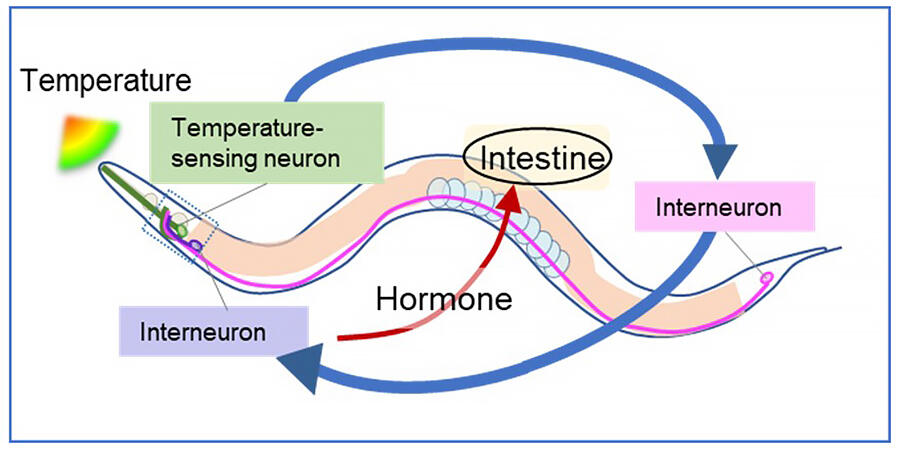The research team of Professor Atsushi Kuhara, graduate student Haruka Motomura, and Junior Associate Professor Akane Ohta of the Graduate School of Natural Science, Konan University has used an analysis of nematodes to show that neurons that sense changes in environmental temperature act on the intestines to adjust the amount of the nematode's intestinal fat, allowing the organism to acclimate to the environmental temperature.

Provided by Kuhara Lab, Konan University
To clarify the response mechanism of living organisms to temperature, it is important to carefully look at the molecular mechanism that receives temperature information, the neural circuits that process that it, and the associated network of nerves and other tissues. However, the human brain is composed of approximately 100 billion nerve cells, so the neural circuits are extremely complex.
Therefore, to understand the temperature response mechanism in animals, the research team analyzed the temperature acclimation of C. elegans, a simple, model experimental animal that has many genes that are similar to those in humans. They found a neural circuit running throughout the worm's body, from head to tail to head, that acts on the intestine to regulate temperature acclimation by altering the amount of fat in the intestine. C. elegans were found to memorize temperatures that they had experienced once in their body, becoming more resilient to that temperature when they received the same temperature stimulus again.
A transcription factor called CREB was also involved in this temperature acclimation process. CREB contributed to changes in temperature sensitivity of the ASJ (thermosensory neuron) in the head in response to the worm's rearing temperature, and temperature acclimation was controlled by the ASJ and downstream RMG (interneuron). Temperature information received by the ASJ in the head is transmitted to the PVQ (interneurons) located in the tail, and further from the PVQ to the RMG in the head. The RMG receives this temperature information and then stimulates the secretion of neuropeptides. The neuropeptides are received by neuropeptide receptors in the intestines, which activate intestinal lipolytic enzymes. This leads to the lipolysis in the intestines, suggesting that, when reared at higher temperatures, the fat content in the intestines decreases and the worms are less able to tolerate lower temperatures.
Professor Kuhara said, "People develop heat stroke or hypothermia when they cannot cope with sudden temperature changes, such as extreme heat, or extreme cold. There are also a number of bioregulatory mechanisms that have been maintained from nematodes to humans. Some mammals store fat in the fall for hibernation, and we hope that the neural circuit model of brain-gut coupling presented here will lead to an understanding of the temperature acclimation mechanisms in higher animals."
■ ASJ (thermosensory neuron): A pair of sensory neurons located on the left and right of the head of C. elegans that receive sensory information from the environment. In addition to being able to sense light, they are known to be temperature sensitive and are involved in low temperature tolerance.
■ RMG (interneurons): A pair of interneurons located on the left and right of the head of C. elegans that bridge information received by sensory neurons. These neurons have been found to be involved in temperature acclimation.
■ PVQ (interneurons): A pair of interneurons located on the left and right of the tail of C. elegans that bridge information received by sensory neurons. Axons project through the abdomen to the head.
Journal Information
Publication: Proceedings of the National Academy of Sciences of USA (PNAS)
Title: Head-tail-head neural wiring underlies gut fat storage in C. elegans temperature acclimation
DOI: 10.1073/pnas.2203121119
Kuhara Lab in Konan University, Japan
This article has been translated by JST with permission from The Science News Ltd.(https://sci-news.co.jp/). Unauthorized reproduction of the article and photographs is prohibited.




